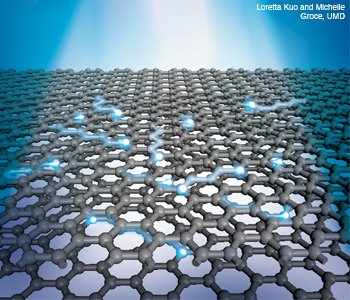
Electrons in bilayer graphene are heated by a beam of light.
Graphene’s unique properties were harnessed to make a sensitive photon detector that operates across the spectrum from the visible to terahertz frequencies. University Maryland researcher Jun Yan and others developed a bolometer using bilayer graphene with a bandgap tuned by electric fields (Nat Nanotechnol: doi:10.1038/nnano.2012.88). The device could be especially useful for astronomers who need a fast, sensitive and low-noise detector of terahertz radiation emitted during the formation of stars and galaxies.
When a photon is absorbed by a bolometer, the material heats up and the resistance changes. Compared to conventional light sensors, bolometers can be exquisitely sensitive to single photons and relatively insensitive to wavelength.
The researchers stacked two layers of graphene and applied an electric field to create a device with a small bandgap. They manipulated the bandgap to allow absorption of the low-energy terahertz photons, while also making the electrical resistance in the material depend strongly on temperature.
The device was tested at 5K. State-of-the-art technology uses superconducting transition-edge detectors, which have a lower noise equivalent power when operated at lower temperature. But, says researcher Michael Fuhrer, “when we extrapolate our device’s performance to lower temperature, [the graphene bilayer bolometer] appears to be superior to the superconducting detectors. It is also faster, which is an advantage in detectors which count individual photons.”
The initial device can be optimized: bilayer graphene doesn’t absorb much light because the resistance is high, although adding a resonator would increase absorption. Also, devising read-out electronics for the fast bolometer could be difficult.
Fuhrer says, “we are working on a new type of detector based on hot electron thermopower in graphene, which we expect will operate at room temperature.”
